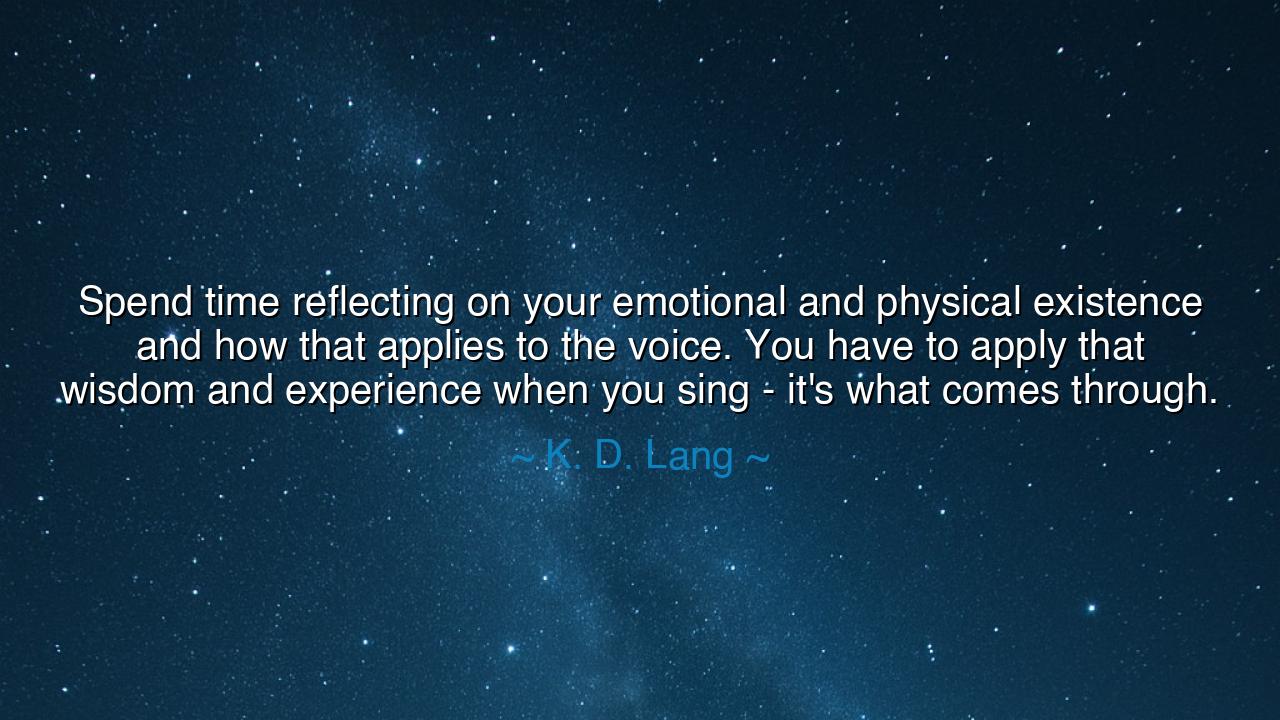
Spend time reflecting on your emotional and physical existence
Spend time reflecting on your emotional and physical existence and how that applies to the voice. You have to apply that wisdom and experience when you sing - it's what comes through.






K. D. Lang, the songstress whose voice carries both fire and tenderness, once declared: “Spend time reflecting on your emotional and physical existence and how that applies to the voice. You have to apply that wisdom and experience when you sing—it’s what comes through.” In these words lies the eternal truth that art is not separate from life. The voice is not merely a sound shaped by breath and muscle, but the echo of the whole being—its sorrows, its triumphs, its unseen depths.
The ancients would have said that the singer does not sing alone. Behind every note stand the countless moments of experience that shape it. To know oneself—the wounds of the heart, the joys of the body, the passage of years—is to give the voice substance and weight. Without this, music is hollow, an empty shell. But when life itself is poured into song, then it becomes living flame, warming those who hear it.
Consider the story of Billie Holiday, who carried her hardships into her singing. Her voice was not perfect in the polished sense, but it was soaked in lived truth—grief, love, resilience. When she sang Strange Fruit, it was not mere melody, but a lamentation carved from the marrow of her existence. That is the wisdom K. D. Lang speaks of: the merging of experience and expression, so that the audience does not just hear but feels the singer’s life within the song.
Thus, the counsel is clear: the artist must turn inward, must reflect upon their emotional and physical existence, for therein lies the fountain of authenticity. The muscles of the body give power, but it is the soul’s wisdom that gives meaning. When both unite, the song transcends technique and becomes revelation.
Let this be a teaching to all who seek to create: do not flee from your scars, nor from your joys. Each is a note in the symphony of your being. To sing, to write, to paint—whatever form the art takes—draw not only from training, but from life itself. For in the end, it is not perfection that moves hearts, but the courage to let your true self come through.






HHhhhhhiiii
I find this message inspiring but also challenging. It asks artists to integrate every part of themselves into their craft, which isn’t easy. How do you sing from a place of truth when you’re still figuring out who you are? Maybe Lang is saying that the voice evolves as the person does—that singing is not just about control, but about self-acceptance and growth over time.
MUMai Uyen
This statement makes me reflect on how often performers focus outward—on impressing others—rather than inward. Lang flips that idea, suggesting that true expression starts with self-understanding. But how does one cultivate that? Maybe it takes slowing down, observing emotions, even embracing imperfections. Perhaps that’s what makes a performance feel real rather than polished.
HTTrinh Thi Hong Tham
There’s something profoundly spiritual about this perspective. It reminds me that music isn’t just communication—it’s embodiment. Lang seems to imply that wisdom and feeling live in the body as much as in the mind. I can’t help but think about how trauma, joy, or memory might shape the tone of a person’s voice. Do singers carry their life stories in their sound without even realizing it?
NKNguyẽn Nam Khánh
What strikes me here is the connection between mindfulness and performance. It’s as if Lang is saying that true artistry comes from being fully present in both body and spirit. I wonder if this applies beyond singing—maybe all creative expression benefits from that kind of introspection. How much of great performance comes from technique versus emotional awareness?
TNThuong Nguyen
This idea resonates with me because it treats singing as something deeply holistic. Lang seems to suggest that the body and emotions are instruments too, not just the voice. It makes me curious—how does one actually translate emotional reflection into sound? Is it something that can be taught, or does it come naturally through lived experience and vulnerability?